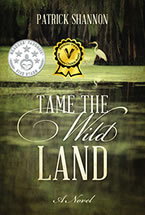Article first published as Book Review: 'Tame the Wild Land' by Patrick Shannon on Blogcritics.
WINNER OF THE 2014 TYLER R. TICHELAAR HISTORICAL FICTION AWARD
IN THE READER VIEWS LITERARY AWARDS CONTEST
May 9, 2015
Tame the Wild Land: A Novel
Patrick Shannon
Outskirts Press (2015)
ISBN: 9781478737636
New Novel Tells Exciting Tale of the French Taming Louisiana
 Tame the Wild Land is a book after my own heart. As a descendant of seventeenth and eighteenth century French Canadians, I’ve always been a lover of the period of history when those ancestors lived and have wanted to know more about it, but while most of what I’ve read has been about Quebec and the Great Lakes region, I’ve known little about the other French settlements, especially in Louisiana. This novel filled a huge gap in French-American history for me, and it was also highly entertaining—exactly what historical fiction should be.
Tame the Wild Land is a book after my own heart. As a descendant of seventeenth and eighteenth century French Canadians, I’ve always been a lover of the period of history when those ancestors lived and have wanted to know more about it, but while most of what I’ve read has been about Quebec and the Great Lakes region, I’ve known little about the other French settlements, especially in Louisiana. This novel filled a huge gap in French-American history for me, and it was also highly entertaining—exactly what historical fiction should be.
The author, Patrick Shannon, has chosen for his main protagonist, Louis de St. Denis, a man I’d never heard of, but I should have. Shannon also happens to be a descendant of St. Denis. As an author myself, I have used my family history as source material for my own historical fiction, so I completely understand why Shannon would make such a choice, but I also know the pitfalls that can be encountered. Shannon avoids all those pitfalls, completely distancing himself from any romantic or exaggerated ideas about his ancestry to tell a story of heroism, adversity, difficulties, and star-crossed love.
Louis de St. Denis was born in Quebec but came to Louisiana to help a struggling French settlement survive and prosper. The novel opens in 1700, the year Louis arrives in Louisiana, in what is now Biloxi Bay, near the mouth of the Mississippi, and where a settlement was founded the year before and has been struggling. The novel is divided into two sections, the first documenting how the settlement struggles to exist during its first six years. A huge part of the challenge is dealing with the local “Indians”—a term Shannon does not shy away from for the more politically correct “Native American.” In fact, I admired that Shannon did not try to insert modern-day sensibilities into the story or his characters’ mouths as too many modern novelists do. Instead, he lets his characters be representative of their historical counterparts and the beliefs and prejudices of the time. I found the interactions the French characters had with the Indians to be fascinating—not only did I not realize so much of the area (Alabama, Natchez, etc.) was named for local Indian tribes, but I found the Indian customs rather horrifying—at one point, a chief dies, and it is customary to have forty Indians killed to go to death with him; when a French priest tries to prevent this unnecessary killing, a war nearly ensues.
Indians become a primary motivator for the second part of the novel as well. To keep the colony alive, the French realize they must trade with the Spanish, even though the Spanish have long refused to do so. A door to possible trade opens when a Spanish priest, who is denied missionary help by his own government, writes to the French, asking them to send priests to aid in his converting the Indian tribes. Louis de St. Denis heads up this mission, hoping it will allow him to introduce trade with the Spanish.
A series of complications ensue during Louis’ mission, including his being taken prisoner by the Spanish, being seen as a traitor by the French, and falling in love with a Spanish girl more than twenty years younger than himself—a star-crossed match that leads to opposition by the girl’s family.
I won’t give away how the story ends, but the novel left me wanting to know more about the history of Louisiana, Texas, and the French and Spanish presence there in the early eighteenth century, as well as more about Louis de St. Denis and more famous personages like Cadillac and LaSalle, who also influence the novel.
Shannon’s style is refreshing and entertaining for the reader. Rather than bog us down with historical details, which too many well-known historical novelists do, including James Michener and Ken Follett, Shannon remembers that his first job is to entertain us and to tell a story about his characters. He is sparse on description, but generous in writing dialogue that moves the story along, while sprinkling in occasional narrative passages to carry the reader to the next scene. I was rather reminded of the style of Evelyn Waugh in this respect.
I congratulate Shannon on this fine novel, and I look forward to reading more of his work as well as further exploring French-American history now that he has whet my interest. Ultimately, a good historical novelist should not educate so much as open the door for his reader to want further education about the historical period the novel has been set in. Shannon has done that very well, indeed.
For more information about Patrick Shannon and Tame the Wild Land, visit http://outskirtspress.com/bookstore/details/9781478737636.
— Tyler R. Tichelaar, Ph.D., and award-winning author of Narrow Lives

